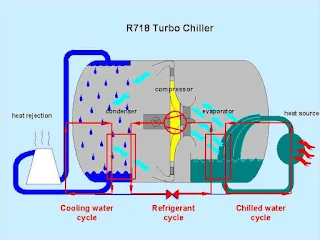radial turbo compressor for water as refrigerant
Post by Arda Rahardja Lukitobudi @ Grup FB IKARA
Untuk artikel PDF Turbo Water Chiller with Water as Refrigerant
Purdue University
Purdue e-Pubs International Compressor Engineering
Conference School of Mechanical Engineering
2004
Turbo Water Chiller with Water as Refrigerant
Eberhard Wobst
Institut fur Luft-und Kaltetechnik
Nikolai Kalitzin
Institut fur Luft-und Kaltetechnik
Rainer Apley
Institut fur Luft-und Kaltetechnik
TURBO WATER CHILLER WITH WATER AS REFRIGERANT
Eberhard WOBST, Nikolai KALITZIN, Rainer APLEY
Institut für Luft- und Kältetechnik gGmbH, Main Department of Refrigeration & Cryogenics,
Dresden, Germany
(++49-351-4081-630, ++49-351-4081-635, eberhard.wobst@ ilkdresden .de)
ABSTRACT
The use of natural refrigerants in energy efficient refrigerating plants becomes more and more important for the
protection of the environment against air pollution e.g. by HFCs and CO 2 . The ILK Dresden is dealing with the
development of turbo water chillers with water as refrigerant. The design of such chillers has to be tailor-made
because of the thermodynamic properties of water. The paper describes the present situation in this ILK working
field. On basis of first experiences with running of these chillers at car manufacturers like DaimlerChrysler or VW
the ILK Dresden will continue its R&D activities in this field.
1. INTRODUCTION
The worldwide restrictions for the use of CFCs and HFCs caused by the proved environmental pollution due to
ozone depletion and greenhouse effect call for the search for environment-friendly refrigerants. The natural
refrigerants like water (R718), air, carbon dioxide (R744), ammonia (R717) and propane (R290) are some of them.
The research and development activities for the use of water as refrigerant for compression refrigerating systems
were started in the Dresden Institut für Luft- und Kältetechnik (ILK Dresden) in 1991. The research resulted in the
two-stage turbo chillers with intercooling. Since 2000 the first of them have been proved in practice.
2. PROPERTIES OF WATER AS REFRIGERANT
The advantages of water as refrigerant are above all its non-limited availability, its low price compared to other
refrigerants, its simple handling and its non-toxicity. Disadvantages are especially the low specific cooling capacity
which results in high volume flows, pressure levels below ambient pressure and high pressure ratios. The
comparison of the most important properties of water and ammonia is shown in Table 1.
3. DESIGN AND FUNCTION OF R718 TURBO CHILLERS
Design and function of the chiller are influenced by the thermodynamic and physical properties of the refrigerant
water. The high pressure ratio requires two-stage systems.
The cold water is expanded to the evaporation pressure at the evaporator inlet distributor and partially evaporated in
this direct heat-exchanger. The evaporation heat which is drawn from the cold water leads to a cool down of the
water. The water vapour is then compressed to a mean pressure in the first stage compressor. Superheated vapour
is cooled down to nearly the saturation temperature by a partial evaporation of water through the direct contact with
water. The water vapour is compressed to condensing pressure by the second stage compressor. The condensation
is also realized by the direct contact of water vapour and cooling water. Because the evaporation and the
condensing pressure are in the range of vacuum it is normally recommended to separate the chiller from outer water
networks (cooling and cold water) by plate-heat-exchangers. Figure 3 shows the design scheme of the two-stage
refrigerating system with all its main components and water as refrigerant. The two radial turbo compressors are the
core of the R718 turbo chiller.
On this basis ILK Dresden developed a type series of R718 turbo chillers for a cooling capacity range of 500 to
1,000 kW. The typical cold water outlet temperatures are between 4 and 10°C. COPs of 4.6 to 7.75 are reached
depending on the load conditions and water temperatures.
Design of an R718 turbo chiller
4. RADIAL TURBO COMPRESSOR
The radial turbo compressor for water as refrigerant is the main component of these chillers. The design of this
compressor is influenced decisively by pressure ratio, volume flow and the medium water vapour. The obtainable
pressure ratio is proportional to the impeller diameter and the square of speed. The volume flow also depends on the
speed, the impeller diameter and the blade and channel width, respectively. The largest compressor of this type,
developed by ILK Dresden, has an impeller diameter of 1.20 m, speed up to 9,200 rpm and generates a cooling
capacity of 1,000 kW for the range of air-conditioning. The pressure ratio amounts to about 2.5 per stage and the
volume flow to about 50 m 3 /s.
The design of the compressor is shown in Figure 4. The intake nozzle with the entry vanes minimizes incidence
losses at the impeller inlet. The impeller transfers kinetic energy to the fluid. Two tandem-arranged diffuser vanes
and the following vane-less diffuser decelerate the flow, increasing the static pressure.
The medium water vapour demands and enables the application of very thin and very lightweight carbon fibre
reinforced impeller blades. But these extremely lightweight blades produce themselves a centrifugal force per
double-blade of 15 kN. On the other side the density of water vapour is this low at the low evaporation
temperatures of 4 to 10°C that the fluid forces are negligible compared to the centrifugal forces. The blades are flat
and therefore they are loaded only along their radial fibres.
Compressor design scheme















%20Desember%202022%20(10).jpeg)






KOMENTAR